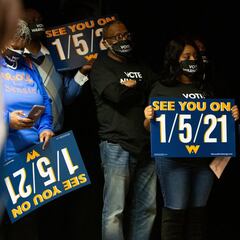US Election: what could happen if no president is elected by 20 January?
Even after the final ballots in the last states have been counted, there will be a recount and the result could be delayed by electoral disputes.

Determining who has really won a presidential election is a lengthy process – especially if it has been a closely-fought race like this year’s between Donald Trump and Joe Biden. Even in normal circumstances, it takes states and Congress about two months after an election to decide who won. States have a set of canvass deadlines once the election is over to compile results – that can vary from one week to four weeks after Election Day, depending on the state. Then there are the certification deadlines in which results are compiled independently. Forty-four states have statutes that will allow the outcome of an election to be contested if a candidate or campaign is not satisfied that the election was conducted correctly. Maine, Michigan, New York, Rhode Island, Wisconsin, and Wyoming are the exceptions.
The 2020 election set a record for voter turnout. But why is it normal for so many Americans to sit out elections? https://t.co/IPQRqUdZqH
— TIME (@TIME) November 7, 2020
Presidential election process
Once states have completed their vote counts and confirmed the official results, the US Code requires the state governors to prepare Certificates of Ascertainment of the vote. These certificates must list the names of the electors chosen by the voters and the number of votes received in the popular election results, also the names of all losing candidates for elector, and the number of votes they received. Certificates of Ascertainment, which are often signed by state governors, must carry the seal of the state. One copy is forwarded to the Archivist of the United States while six duplicates must be provided to the electors by Monday 14 December, the date on which they meet.
There is also the Safe Harbor Deadline, which this year, falls on Tuesday 8 December. If election results are contested in any state, and if the state, prior to election day, has enacted procedures to settle controversies or contests over electors and electoral votes, and if these procedures have been applied, and the results have been determined six days before the electors’ meetings, then these results are considered to be conclusive, and will apply in the counting of the electoral votes. The governor of any state where there was a contest, and in which the contest was decided according to established state procedures, is required to send a certificate describing the form and manner by which the determination was made to the Archivist as soon as possible.
Six days later on 14 December, the electors will meet to cast paper ballots for president and vice president. After counting the votes, the electors send them to the president of the US Senate, the vice president, by the fourth Wednesday in December, or in the case of this year Wednesday 23 December 2020.
See also:
When will military ballots be counted in Georgia?
What's the difference between popular vote and electoral college vote?
Can Donald Trump barricade the White House and refuse to leave?
What happens if the 2020 election goes to the Supreme Court?
Congress to declare results on 6 January
Related stories
The process culminates with a joint session of Congress at 13:00 hours on 6 January to count electoral votes and declare the results. The Vice President opens the certificates and presents them to four tellers, two from each chamber. The tellers will read out and make a list of the returns. When the votes have been ascertained and counted, the tellers transmit them to the Vice President. If one of the tickets has received a majority of 270 or more electoral votes, the Vice President announces the results, which “shall be deemed a sufficient declaration of the persons, if any, elected President and Vice President”. If neither candidate gets 270 Electoral College votes, the Constitution requires the House of Representatives to pick the President.
At noon on Wednesday 20 January 2021, the President and Vice President will be sworn in on the West Front of the Capitol. The Vice President takes the oath first, followed by the President. However, Trump has threatened that he would not accept the results of the 2020 presidential election if he were to lose, arguing that increased postal voting has led to fraud and cited Ohio as an example. But under the 20th Amendment, if Trump loses the election, he would have no choice but to leave office well in advance of 20 January – even if he believes that the election was rigged and in spite of his threats of legal action.

